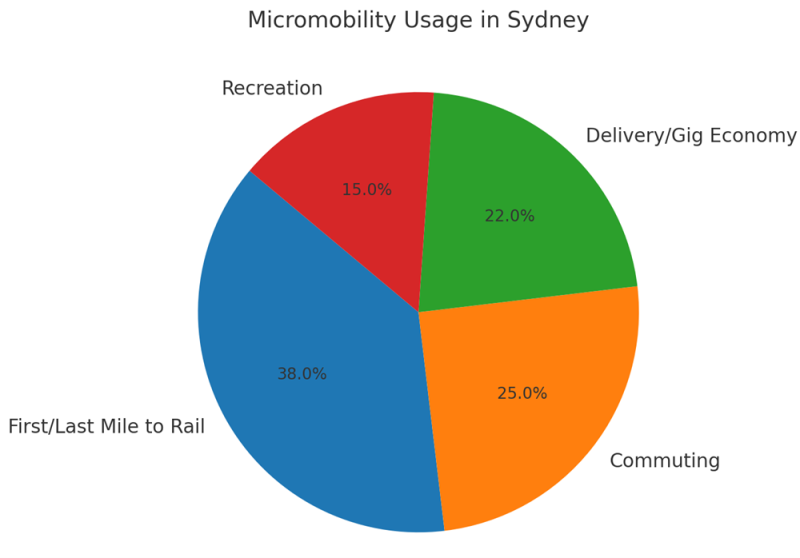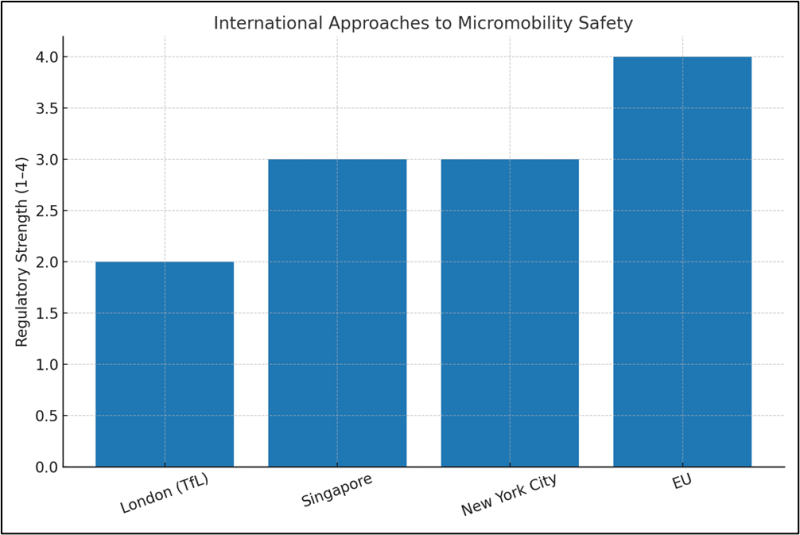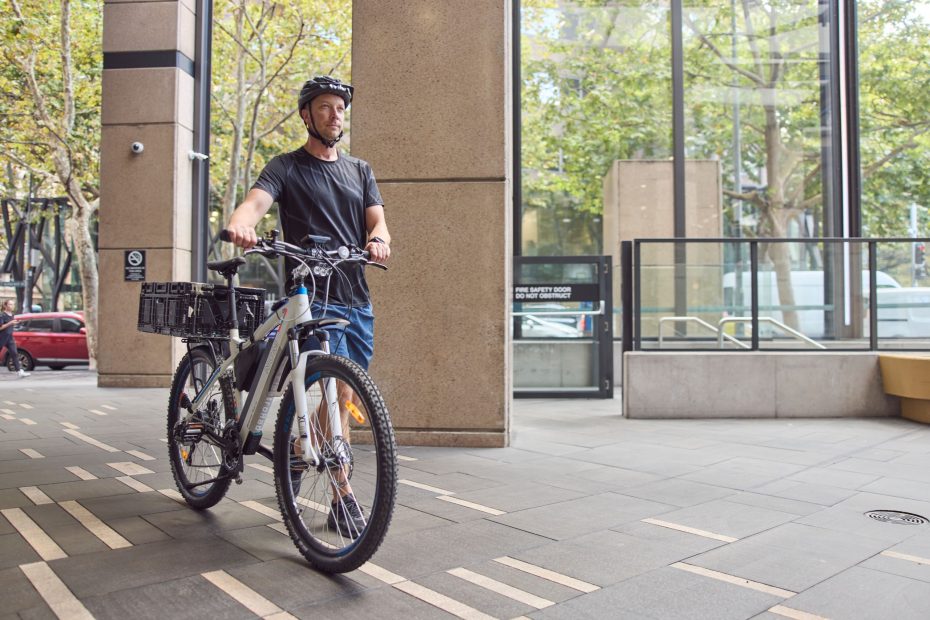Submissions to Transport for NSW close 3 September
https://www.haveyoursay.nsw.gov.au/changes-using-e-micromobility-public-transport
Executive Summary
EcoTransit Sydney Incorporated submits this White Paper to Transport for NSW in response to the proposed temporary prohibition on the carriage of e-micromobility devices (e-bikes, e-scooters, e-skateboards and similar battery-powered devices) on Sydney Trains, Sydney Metro and NSW TrainLink services.
EcoTransit recognises the seriousness of lithium-ion battery fires and their unique risk profile in confined rail environments. However, a blanket ban would be disproportionate, inequitable, and inconsistent with NSW Government strategies that aim to:
- Increase the public and active transport mode share (Future Transport Strategy 2056);
- Reduce emissions under the Net Zero Plan Stage 1: 2020–2030;
- Expand cycling and micromobility uptake (Active Transport Strategy 2022).
We propose an alternative framework that combines battery certification, enforcement, infrastructure investment, and public education. This approach aligns with international best practice and preserves the critical role of micromobility in supporting sustainable transport outcomes.
Submission to Transport for NSW
Safety Considerations
EcoTransit Sydney recognises that lithium-ion battery fires can pose serious risks in confined environments such as trains and underground stations. However, these risks are not uniform across all devices. Certified and standards-compliant devices present significantly lower risks than uncertified or modified batteries. International practice has demonstrated the effectiveness of certification and enforcement regimes rather than blanket bans.
Impacts of a Blanket Ban
- Mode Shift: A ban risks discouraging public transport use by removing first- and last-mile connections.
- Equity: Low-income, shift workers, and gig economy riders would be disproportionately affected.
- Regional NSW: E-bikes often provide the only connection to intercity services.
- Policy Contradiction: The proposal is inconsistent with Future Transport Strategy 2056, the Active Transport Strategy, and the Net Zero Plan.
Integrated Transport Utility
The integration of e-bikes with the rail network significantly enhances the reach, efficiency, and overall appeal of public transport. Sydney Metro has been deliberately designed with cyclists in mind – featuring large lifts, level access between trains and platforms, and dual-door lift access to facilitate seamless movement of bicycles, cargo bikes, and other mobility devices.
This infrastructure enables commuters to address the “first and last mile” challenge with ease, extending the effective catchment area of the Metro and ensuring greater return on the State’s substantial investment in underground rail.
Practical experience demonstrates that combining cycling with rail offers faster, more cost-effective, and more convenient journeys than private car use, while also delivering lifestyle benefits such as school drop-offs, grocery transport, and recreational trips. In short, the freedom that car advertising claims to offer is, in reality, provided more effectively through the integration of e-mobility with rail.
A blanket ban on e-bikes and e-mobility devices within the rail system would undermine these benefits and risk increasing car dependency at a time of heightened cost-of-living pressures. Rather than resorting to restrictive measures, the appropriate response lies in robust regulation of battery safety, including import screening, annual inspections, and subsidised professional replacement programs. Such measures would not only mitigate fire risks but also foster the development of a domestic e-mobility industry, creating jobs and reducing costs for consumers.
Should rail access be withdrawn, large-scale investment in secure bicycle parking would become necessary; however, this represents a less efficient and less attractive solution compared to enabling seamless bike-and-ride journeys.
The proposed ban reflects a short-sighted policy approach that fails to appreciate the vital role of micro-mobility in supporting rail patronage, reducing congestion, and promoting sustainable, affordable transport for the community.
Recommendations
EcoTransit Sydney recommends that Transport for NSW:
- Reject a blanket ban in favour of a standards-based regulatory approach.
- Mandate visible certification labels for devices carried on trains.
- Provide station infrastructure such as secure storage and charging lockers.
- Limit any temporary ban to a maximum of 12 months, subject to an independent review and published safety data.
Conclusion
EcoTransit Sydney supports Transport for NSW’s priority of passenger safety. However, this must be achieved through proportionate, evidence-based regulation. A standards-based framework, combined with infrastructure investment and enforcement, offers a more effective and sustainable approach than a blanket ban. We urge Transport for NSW to align safety policy with the State’s broader sustainability and equity commitments.
Figure 1: Micromobility Usage in Sydney

Figure 2: International Approaches to Micromobility Safety

Table 1: Comparison of International Standards for E-Micromobility Batteries
| Standard | Jurisdiction / Body | Scope & Key Features | Application in Public Transport Context |
| AS/NZS 60335 | Australia & New Zealand | Household appliances – safety of lithium-ion packs | Mandatory but not consistently enforced for micromobility |
| IEC 62133 | International (IEC) | Rechargeable cells and battery systems safety | Global baseline, adopted in Europe and Asia |
| UL 2272 | United States / Singapore | Electrical & fire safety standard for mobility devices | Singapore requires UL2272 for all public devices |
| UN 38.3 | United Nations | Testing for safe transport of lithium-ion batteries | Applied in shipping, aviation, logistics |
Data Source: AS/NZS 60335, IEC 62133, UL 2272, UN 38.3 standards documentation.
Table 2: Impacts of Blanket Ban vs. Standards-Based Regulation
| Category | Blanket Ban | Standards-Based Regulation |
| Safety | Reduces risk indiscriminately | Targets unsafe devices while allowing safe use |
| Mode Shift | Risk of increased car dependency | Supports rail patronage and first/last mile links |
| Equity | Disproportionate burden on low-income workers | Maintains access with safeguards |
| Policy Alignment | Contradicts NSW strategies | Reinforces NSW commitments |
| Feasibility | Simple to enforce but blunt | Requires certification & enforcement |
| Public Perception | Seen as anti-cycling | Seen as balanced & evidence-based |
Data Source: EcoTransit Sydney policy analysis, informed by Transport for NSW Future Transport Strategy 2056, Active Transport Strategy 2022, and Net Zero Plan Stage 1: 2020–2030.
Table 3: International Responses to E-Micromobility Fire Risks
| City / Region | Approach Taken | Outcome / Lessons Learned |
| London (TfL) | Banned uncertified e-scooters; certified folding devices permitted | Maintains safety while preserving flexibility |
| Singapore | Introduced UL2272 certification and disposal schemes | Fire incidents reduced significantly |
| New York City | Certification requirement, charging facilities, bans on uncertified imports | Improved safety, maintained rider mobility |
| European Union | Strengthened Battery Directive with producer responsibility | Improved system-wide quality and recycling |
Data Source: Transport for London (TfL) Personal Mobility Device Policy, 2022; Land Transport Authority (Singapore) UL2272 Standards, 2019; FDNY Fire Safety Report, 2023; European Union Battery Directive, 2020.
Table 4: Micromobility Use in Sydney – Functional Categories (Survey Estimates)
| Use Case | Share of Trips (%) | Notes |
| First/Last Mile to Rail | 38% | Key support for public transport patronage |
| Commuting (end-to-end) | 25% | High use in Inner West and Parramatta LGAs |
| Delivery / Gig Economy | 22% | Significant reliance in CBD and Inner West |
| Recreational / Social | 15% | Growing but secondary to transport-focused use |
Data Source: WeRide Australia E-Bike Subsidy Report, 2021; UTS Institute for Sustainable Futures (2022) research.
Notes on Charts, Tables, and Statistics
These figures are sourced from industry reports, government strategies, and international best practice studies:
- In 2021–22, total bicycle imports into Australia (including e-bikes) reached approximately 1.53 million units, nearly matching the 2020–21 record of 1.69 million units (The Latz Report, 2022).
- Studies show that between 40% and 50% of trips made by e-bike replace car journeys (WeRide Australia, 2021–22).
- Micromobility delivers significant wider benefits, including $18.6 billion in economic and social value, 514,096 tonnes of CO₂-e avoided emissions, and 3.9 billion km of motor vehicle travel avoided (WeRide/EY Australian Cycling Economy Report, 2022).
- International research confirms that micromobility provides vital first- and last-mile connections to transit (World Transit Research, 2020).
- In New York City, the FDNY reported 267 lithium-ion battery fires and 18 fatalities in 2023 (FDNY Fire Safety Report, 2023).
References
- Transport for NSW, Future Transport Strategy 2056, NSW Government, 2018.
- Transport for NSW, Active Transport Strategy, NSW Government, 2022.
- NSW Government, Net Zero Plan Stage 1: 2020–2030, 2020.
- The Latz Report, ‘Australian Bicycle Imports Top 1.5 Million for the Second Time Ever’, 2022.
- WeRide Australia & Ernst & Young, ‘The Economic Contribution of Cycling in Australia’, 2022.
- WeRide Australia, ‘E-Bike Subsidy Report’, 2021.
- World Transit Research, ‘The First and Last Mile Problem: Micromobility and Transit Integration’, 2020.
- Fire Department of New York (FDNY), Lithium-Ion Battery Fire Safety Report, 2023.
- Transport for London (TfL), Personal Mobility Device Policy, 2022.
- Land Transport Authority (Singapore), UL2272 Certification Requirements, 2019.
- New York City Fire Department, Lithium-Ion Battery Regulations, 2023.
- European Union, Battery Directive, 2020.
